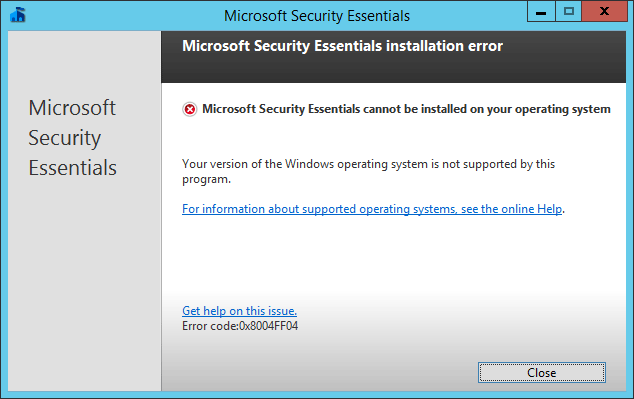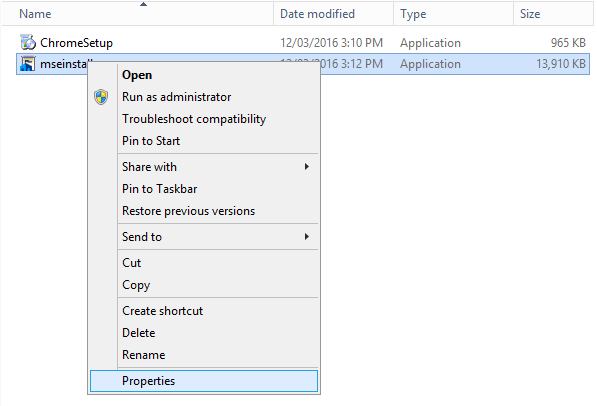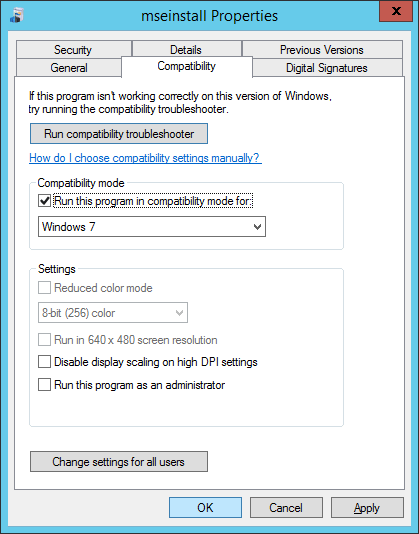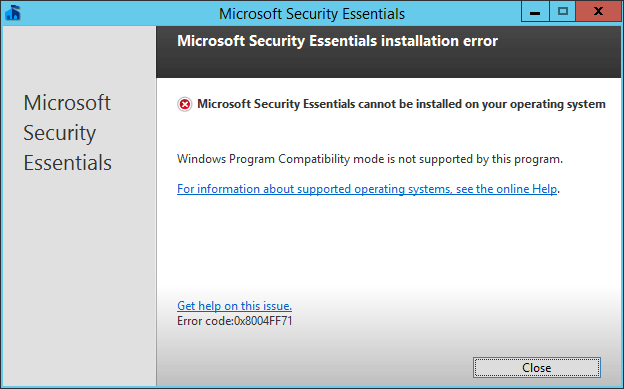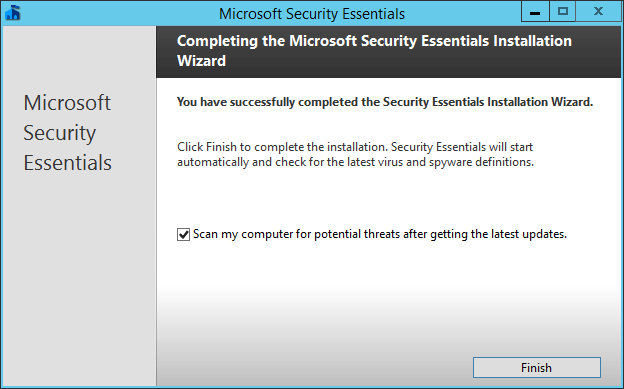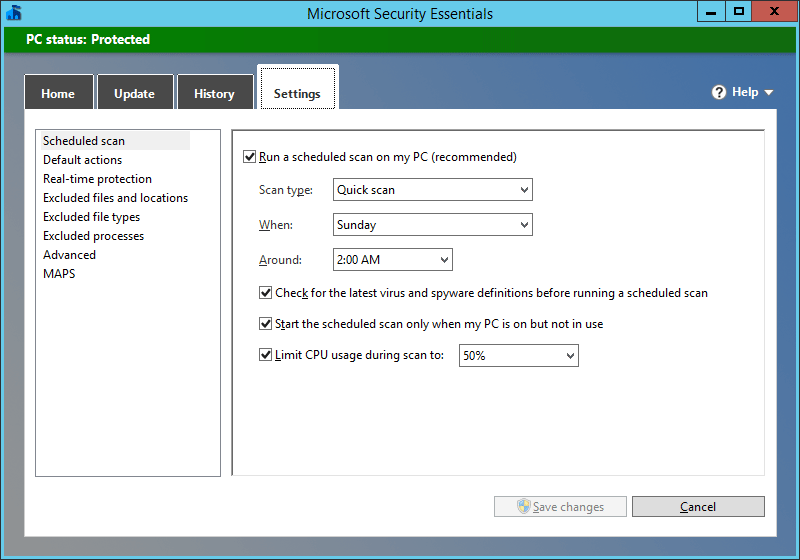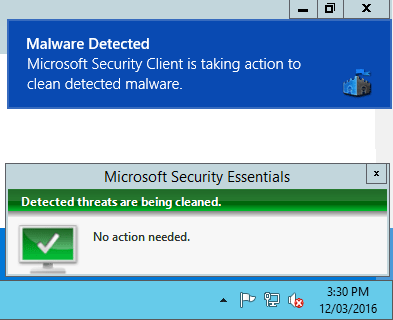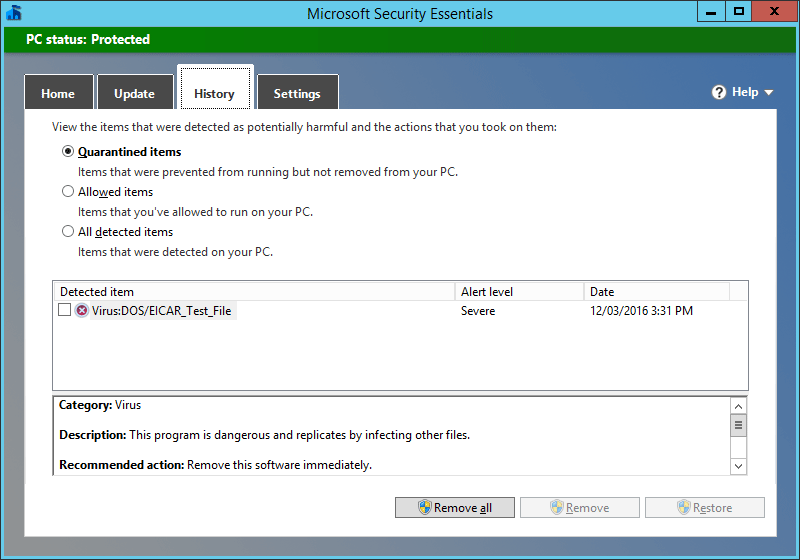- Remove From My Forums
-
Question
-
In Server Core, Windows Defender is enabled by default on Windows Server 2012 r2, without a GUI. If the instalation has a GUI and Desktop Experience enabled, is there is way to enable Windows Defender?
All replies
-
Windows Defender is not in any 2012 product not sure how you are seeing that especially on Core. But this article explains it a bit. Windows defender is a consumer product and 2012 is not.
http://blogs.technet.com/b/clientsecurity/archive/2012/11/05/more-information-on-microsoft-antimalware-protection-on-windows-8-and-windows-server-2012.aspx
-
That article refers to Windows Server 2012, not to Windows Server 2012 r2. I knew about WS 2012, I need to know about WS 2012 r2. I know for sure that Windows Defender exists and it is enabled by default on Windows Server Core, even if the WD does not
a have a GUI.-
Edited by
Thursday, May 8, 2014 9:07 PM
-
Edited by
-
Hi,
Thanks for your posting.
As Globalrmunyan mentioned, Windows Defender is not supported in Windows server 2012 or r2.
Please refer to the following article:
Secure Windows Server 2012 R2 and Windows Server 2012
http://technet.microsoft.com/library/hh831360
Regards.
Vivian Wang
-
Marked as answer by
Vivian_Wang
Monday, May 19, 2014 7:43 AM -
Unmarked as answer by
Lotusisrael
Thursday, September 18, 2014 6:48 AM
-
Marked as answer by
-
Vivian, that is really not true.
See http://technet.microsoft.com/en-US/library/hh831778 «What changed in Windows Server 2012 R2» -> «Windows Defender» on the bottom and you will see:
«Available and enabled by default on Server Core installation options and Core System Server (without the user interface).
For more information, see
Windows Defender.»So on Core installation, it really IS present.
Jaroslav Sabacky
-
Proposed as answer by
Milos Puchta
Saturday, April 18, 2015 9:57 PM
-
Proposed as answer by
-
I knew it was present on Server Core, this is why I wished to know if there is any way to enable it on Server with a GUI as well.
-
Did you get any answer on this?
All my findings are the same so far, that it is enabled and install as default on 2012 R2Core, but no information regarding Full GUI.
And that it was not supported on 2012.
-
Hi,
Thanks for your posting.
As Globalrmunyan mentioned, Windows Defender is not supported in Windows server 2012 or r2.
Please refer to the following article:
Secure Windows Server 2012 R2 and Windows Server 2012
http://technet.microsoft.com/library/hh831360
Regards.
Vivian Wang
Not exactly true. Defender IS INCLUDED in 2012 R2 under the Desktop Experience. However, it isn’t included there in the Foundation edition.
Capt. Dinosaur
-
Vivian, that is really not true.
See http://technet.microsoft.com/en-US/library/hh831778 «What changed in Windows Server 2012 R2» -> «Windows Defender» on the bottom and you will see:
«Available and enabled by default on Server Core installation options and Core System Server (without the user interface).
For more information, see
Windows Defender.»So on Core installation, it really IS present.
Jaroslav Sabacky
Hi Jaroslay,
I understand what you’re saying, however I did find a slightly different story. I followed a link in another thread which took me to a page called, «Greg Olsen — Yellow Duck Guy-«, who says that Defender is included in the Desktop Experience
feature. Here’s the link:Windows Server 2012 – How to Add Desktop Experience Feature
He provides step-by-step instructions to install that feature. I followed his instructions and installed the feature, but in Foundation edition Defender is not included. I’ve just installed a Evaluation Copy of Standard, and am installing the
Desktop Experience there to see if it truly does include Defender.Back from the test and GLUBB!!! I guess you’re correct, because in spite of what the Yellow Duck Guy says, Defender is not in the Desktop Experience of Standard either.
Capt. Dinosaur
-
It bites. Microsoft seems to have left a hole for small installations.
System Center 2012 Endpoint Protection is recommended for Windows Server 2012 R2 but it is too complicated and expensive. We just have a few servers on Amazon Web Service, what is a good solution for endpoint protection?
-
1. Download Windows Security Essentials for Windows 7
2. Right click on mseinstall.exe and select Properties
3. Click the Compatibility tab
4. Check the Run this program in compatibility mode for: box
5. Select Windows 7 from the pull down menu
6. Click OK
7. Open a Command Prompt as Administrator
8. Navigate to the directory with mseinstall.exe
9. At the command prompt type «mseinstall.exe /disableoslimit» without quotes
10. Press enter and install normally
-
This is basically SCEP for the public.
-
thank you. working on MS Server 2012r2
-
As of the EOL of Windows 7, the download for MSE is no longer available.
- Remove From My Forums
-
Question
-
In Server Core, Windows Defender is enabled by default on Windows Server 2012 r2, without a GUI. If the instalation has a GUI and Desktop Experience enabled, is there is way to enable Windows Defender?
All replies
-
Windows Defender is not in any 2012 product not sure how you are seeing that especially on Core. But this article explains it a bit. Windows defender is a consumer product and 2012 is not.
http://blogs.technet.com/b/clientsecurity/archive/2012/11/05/more-information-on-microsoft-antimalware-protection-on-windows-8-and-windows-server-2012.aspx
-
That article refers to Windows Server 2012, not to Windows Server 2012 r2. I knew about WS 2012, I need to know about WS 2012 r2. I know for sure that Windows Defender exists and it is enabled by default on Windows Server Core, even if the WD does not
a have a GUI.-
Edited by
Thursday, May 8, 2014 9:07 PM
-
Edited by
-
Hi,
Thanks for your posting.
As Globalrmunyan mentioned, Windows Defender is not supported in Windows server 2012 or r2.
Please refer to the following article:
Secure Windows Server 2012 R2 and Windows Server 2012
http://technet.microsoft.com/library/hh831360
Regards.
Vivian Wang
-
Marked as answer by
Vivian_Wang
Monday, May 19, 2014 7:43 AM -
Unmarked as answer by
Lotusisrael
Thursday, September 18, 2014 6:48 AM
-
Marked as answer by
-
Vivian, that is really not true.
See http://technet.microsoft.com/en-US/library/hh831778 «What changed in Windows Server 2012 R2» -> «Windows Defender» on the bottom and you will see:
«Available and enabled by default on Server Core installation options and Core System Server (without the user interface).
For more information, see
Windows Defender.»So on Core installation, it really IS present.
Jaroslav Sabacky
-
Proposed as answer by
Milos Puchta
Saturday, April 18, 2015 9:57 PM
-
Proposed as answer by
-
I knew it was present on Server Core, this is why I wished to know if there is any way to enable it on Server with a GUI as well.
-
Did you get any answer on this?
All my findings are the same so far, that it is enabled and install as default on 2012 R2Core, but no information regarding Full GUI.
And that it was not supported on 2012.
-
Hi,
Thanks for your posting.
As Globalrmunyan mentioned, Windows Defender is not supported in Windows server 2012 or r2.
Please refer to the following article:
Secure Windows Server 2012 R2 and Windows Server 2012
http://technet.microsoft.com/library/hh831360
Regards.
Vivian Wang
Not exactly true. Defender IS INCLUDED in 2012 R2 under the Desktop Experience. However, it isn’t included there in the Foundation edition.
Capt. Dinosaur
-
Vivian, that is really not true.
See http://technet.microsoft.com/en-US/library/hh831778 «What changed in Windows Server 2012 R2» -> «Windows Defender» on the bottom and you will see:
«Available and enabled by default on Server Core installation options and Core System Server (without the user interface).
For more information, see
Windows Defender.»So on Core installation, it really IS present.
Jaroslav Sabacky
Hi Jaroslay,
I understand what you’re saying, however I did find a slightly different story. I followed a link in another thread which took me to a page called, «Greg Olsen — Yellow Duck Guy-«, who says that Defender is included in the Desktop Experience
feature. Here’s the link:Windows Server 2012 – How to Add Desktop Experience Feature
He provides step-by-step instructions to install that feature. I followed his instructions and installed the feature, but in Foundation edition Defender is not included. I’ve just installed a Evaluation Copy of Standard, and am installing the
Desktop Experience there to see if it truly does include Defender.Back from the test and GLUBB!!! I guess you’re correct, because in spite of what the Yellow Duck Guy says, Defender is not in the Desktop Experience of Standard either.
Capt. Dinosaur
-
It bites. Microsoft seems to have left a hole for small installations.
System Center 2012 Endpoint Protection is recommended for Windows Server 2012 R2 but it is too complicated and expensive. We just have a few servers on Amazon Web Service, what is a good solution for endpoint protection?
-
1. Download Windows Security Essentials for Windows 7
2. Right click on mseinstall.exe and select Properties
3. Click the Compatibility tab
4. Check the Run this program in compatibility mode for: box
5. Select Windows 7 from the pull down menu
6. Click OK
7. Open a Command Prompt as Administrator
8. Navigate to the directory with mseinstall.exe
9. At the command prompt type «mseinstall.exe /disableoslimit» without quotes
10. Press enter and install normally
-
This is basically SCEP for the public.
-
thank you. working on MS Server 2012r2
-
As of the EOL of Windows 7, the download for MSE is no longer available.
- Remove From My Forums
-
Question
-
In Server Core, Windows Defender is enabled by default on Windows Server 2012 r2, without a GUI. If the instalation has a GUI and Desktop Experience enabled, is there is way to enable Windows Defender?
All replies
-
Windows Defender is not in any 2012 product not sure how you are seeing that especially on Core. But this article explains it a bit. Windows defender is a consumer product and 2012 is not.
http://blogs.technet.com/b/clientsecurity/archive/2012/11/05/more-information-on-microsoft-antimalware-protection-on-windows-8-and-windows-server-2012.aspx
-
That article refers to Windows Server 2012, not to Windows Server 2012 r2. I knew about WS 2012, I need to know about WS 2012 r2. I know for sure that Windows Defender exists and it is enabled by default on Windows Server Core, even if the WD does not
a have a GUI.-
Edited by
Thursday, May 8, 2014 9:07 PM
-
Edited by
-
Hi,
Thanks for your posting.
As Globalrmunyan mentioned, Windows Defender is not supported in Windows server 2012 or r2.
Please refer to the following article:
Secure Windows Server 2012 R2 and Windows Server 2012
http://technet.microsoft.com/library/hh831360
Regards.
Vivian Wang
-
Marked as answer by
Vivian_Wang
Monday, May 19, 2014 7:43 AM -
Unmarked as answer by
Lotusisrael
Thursday, September 18, 2014 6:48 AM
-
Marked as answer by
-
Vivian, that is really not true.
See http://technet.microsoft.com/en-US/library/hh831778 «What changed in Windows Server 2012 R2» -> «Windows Defender» on the bottom and you will see:
«Available and enabled by default on Server Core installation options and Core System Server (without the user interface).
For more information, see
Windows Defender.»So on Core installation, it really IS present.
Jaroslav Sabacky
-
Proposed as answer by
Milos Puchta
Saturday, April 18, 2015 9:57 PM
-
Proposed as answer by
-
I knew it was present on Server Core, this is why I wished to know if there is any way to enable it on Server with a GUI as well.
-
Did you get any answer on this?
All my findings are the same so far, that it is enabled and install as default on 2012 R2Core, but no information regarding Full GUI.
And that it was not supported on 2012.
-
Hi,
Thanks for your posting.
As Globalrmunyan mentioned, Windows Defender is not supported in Windows server 2012 or r2.
Please refer to the following article:
Secure Windows Server 2012 R2 and Windows Server 2012
http://technet.microsoft.com/library/hh831360
Regards.
Vivian Wang
Not exactly true. Defender IS INCLUDED in 2012 R2 under the Desktop Experience. However, it isn’t included there in the Foundation edition.
Capt. Dinosaur
-
Vivian, that is really not true.
See http://technet.microsoft.com/en-US/library/hh831778 «What changed in Windows Server 2012 R2» -> «Windows Defender» on the bottom and you will see:
«Available and enabled by default on Server Core installation options and Core System Server (without the user interface).
For more information, see
Windows Defender.»So on Core installation, it really IS present.
Jaroslav Sabacky
Hi Jaroslay,
I understand what you’re saying, however I did find a slightly different story. I followed a link in another thread which took me to a page called, «Greg Olsen — Yellow Duck Guy-«, who says that Defender is included in the Desktop Experience
feature. Here’s the link:Windows Server 2012 – How to Add Desktop Experience Feature
He provides step-by-step instructions to install that feature. I followed his instructions and installed the feature, but in Foundation edition Defender is not included. I’ve just installed a Evaluation Copy of Standard, and am installing the
Desktop Experience there to see if it truly does include Defender.Back from the test and GLUBB!!! I guess you’re correct, because in spite of what the Yellow Duck Guy says, Defender is not in the Desktop Experience of Standard either.
Capt. Dinosaur
-
It bites. Microsoft seems to have left a hole for small installations.
System Center 2012 Endpoint Protection is recommended for Windows Server 2012 R2 but it is too complicated and expensive. We just have a few servers on Amazon Web Service, what is a good solution for endpoint protection?
-
1. Download Windows Security Essentials for Windows 7
2. Right click on mseinstall.exe and select Properties
3. Click the Compatibility tab
4. Check the Run this program in compatibility mode for: box
5. Select Windows 7 from the pull down menu
6. Click OK
7. Open a Command Prompt as Administrator
8. Navigate to the directory with mseinstall.exe
9. At the command prompt type «mseinstall.exe /disableoslimit» without quotes
10. Press enter and install normally
-
This is basically SCEP for the public.
-
thank you. working on MS Server 2012r2
-
As of the EOL of Windows 7, the download for MSE is no longer available.
On earlier versions of Windows client and server you could install Microsoft Security Essentials, free antivirus from Microsoft. In Windows 8 client, it is integrated into Windows Defender. However, I see no such option in Windows Server 2012 and attempts to install MSE fail.
asked Dec 22, 2012 at 20:02
kinokijufkinokijuf
8,1079 gold badges54 silver badges96 bronze badges
4
I set the compatibility mode for the installer to Windows 7 and then started it with the /disableoslimit command line parameter.
answered Feb 16, 2013 at 18:02
kinokijufkinokijuf
8,1079 gold badges54 silver badges96 bronze badges
3
Currently the answer is «It’s not supported on Server operating systems», as Microsoft doesn’t list Server (2012) as a supported OS.
From MS’ MSE requirements page:
Microsoft Security Essentials is free* and easy to download and use.
Here’s what you need to run it:Operating System: Windows XP Service Pack 3 (SP3); Windows Vista
(Service Pack 1, or Service Pack 2); Windows 7*
As with previous versions you may be able to unofficially install them at some point, but for now, it’s not compatible.
answered Dec 27, 2012 at 21:00
Ƭᴇcʜιᴇ007Ƭᴇcʜιᴇ007
111k19 gold badges198 silver badges262 bronze badges
0
Security Essentials lists only the client operating systems XP, Vista, Win 7 as supported. Windows 8 is very specifically noted as not supported. Since Server 2012 has the same core, it would be normal to assume that it isn’t supported.
Windows 8 currently isn’t supported. Please see the system requirements page for a complete list of operating systems that Microsoft Security Essentials supports.
from http://windows.microsoft.com/en-US/windows/i-cant-install-microsoft-security-essentials
answered Dec 27, 2012 at 21:11
BlackbeagleBlackbeagle
6,62620 silver badges25 bronze badges
1

Краткая инструкция по установке антивируса Microsoft Security Essentials на операционную систему Windows 2012R2 x64
Краткая инструкция по установке антивируса Microsoft Security Essentials на операционную систему Windows 2012 R2 x64.
Аналогичным способом можно установить антивирус и в ОС Windows 8.
1. Скачиваем x64 версию антивируса: mseinstall.exe или выбираем нужную версию здесь: http://windows.microsoft.com/en-us/windows/security-essentials-all-versions
2. В свойствах этого файл, ставим совместимость с Windows 7 и запуск от имени Администратора, а так же нажимаем на: Применить для всех пользователей
3. Запускаем интерпретатор командной строки cmd.exe
4. В открывшемся окне пишем команду установки антивируса.
Будем считать, что файл был сохранён в корне диска D.
Тогда команда будет выглядеть следующим образом:
D:mseinstall.exe /disableoslimit
На этом всё.
18 марта 2020, 14:24
Александр
Windows
0
430
0
Из этой категории
-
Очистка RDP подключения
Перенос папки пользователя и администратора на другой диск windows server
Показать скрытые устройства в диспетчере устройств Windows 7
Этому файлу не сопоставлена программа для выполнения этого действия
Исчезла служба Диспетчер печати в Windows Server 2012
Ошибка 80072efe
Восстановление загрузки Windows Server 2012 R2/2012
Установка драйвера HP LaserJet 1320 в Windows Server 2012
Нет доступа к Windows 10 по сети. Ошибка 0x80004005. Windows 10 не видит компов в сети.
Ошибка 0x00000709
Комментарии ()
Вы должны авторизоваться, чтобы оставлять комментарии.
- Категория: Windows
- 20 марта 2018
- 22 марта 2018
- 11574
В данном случае понадобилось установить Windows Defender на Windows Server 2012 r2. Основная проблема в том, что на офф сайте Microsoft, на сегодняшний день присутствуют только релизы для Windows Vista / Windows 7, а сам установочный пакет ни в какую не устанавливается в ОС, выдавая подряд несколько ошибок — 0x8004FF04 и 0x8004FF71… Итак для начала необходимо загрузить Windows Defender с офф сайта.
Решение ошибки — 0x8004FF04
Решается вопрос просто — перед запуском установщика необходимо в свойства установочного пакеты выставить режим совместимости в Windows 7
Решение ошибки — 0x8004FF71
Устанавливать антивирусный пакет нужно из командой строки с аргументом /disableoslimit, для этого необходимо открыть командную строку от имени Администратора > перейти в каталог, куда загружен установочный пакет > выполнить установку используя команду:
mseinstall.exe /disableoslimit
После установки запустить обновление:
Обновиться:
Пользоваться:
Проверено на Windwows Server 2012 R2 6.3 (Build 9600) со всеми последними апдейтами:
Done.
Posted by BakerWV 2021-02-26T19:20:12Z
Hi
I’m reading that Windows Defender comes by default on Server 2012R2.
When i run the command ‘sc query windefend’, i get an error that says
‘The specified service does not exist as an installed service’
I dont need to enable the feature ‘desktop experience’ for this enable do i? I thought that was just to get the GUI interface.
The OS Version is 6.3.9600 Build 9600
5 Replies
-
What I gathered from TechNet Opens a new window Opens a new window is that Windows Defender is not actually available for Server 2012 r2.
Here’s a workaround:
1. Download Windows Security Essentials for Windows 7 (https://www.microsoft.com/en-us/download/details.aspx?id=5201 Opens a new window)
2. Right click on mseinstall.exe and select Properties
3. Click the Compatibility tab
4. Check the Run this program in compatibility mode for: box
5. Select Windows 7 from the pull down menu
6. Click OK
7. Open a Command Prompt as Administrator
8. Navigate to the directory with mseinstall.exe
9. At the command prompt type «mseinstall.exe /disableoslimit» without quotes
10. Press enter and install normally
Was this post helpful?
thumb_up
thumb_down
-
Are you sure about that? I don’t think it does. What you CAN do is copy it from another Windows box and paste it on 2012 R2.
Was this post helpful?
thumb_up
thumb_down
-
OP
BakerWV
This person is a verified professional.
Verify your account
to enable IT peers to see that you are a professional.poblano
Phil7965
Do you have process on how to make that happen? Is it an .exe?
I was googling and see a few comments on some Microsoft forums, as well as seen a few videos on youtube. Go figure, the internet lead me in the wrong direction.
Was this post helpful?
thumb_up
thumb_down
-
mace
Windows Server Expert
-
check
120
Best Answers -
thumb_up
969
Helpful Votes
Suppose you are running a Core version of Windows Server 2012 R2, most probably as a hypervisor host. If that is the case, I would recommend avoiding installing any AV software on that server and using built-in Hyper-V features to strengthen its security https://www.hyper-v.io/hyper-v-security-mistakes-dont-want-make/ Opens a new window. Injecting components from a desktop Windows 7 OS to the server OS is a bad idea, to be honest.
Was this post helpful?
thumb_up
thumb_down
-
check
-
OP
BakerWV
This person is a verified professional.
Verify your account
to enable IT peers to see that you are a professional.poblano
We decided to go with Microsoft Security Essentials on these 2012 servers.
The server is a 2012r2 Datacenter image running on a VM for testing various options. We have about 20 servers running version 2012r2 and currently exploring our AV options for the future.
Thank you.
Was this post helpful?
thumb_up
thumb_down
Начиная с Windows 8 продукт Windows Defender (Защитник Windows) получил функционал Microsoft Security Essentials и из
простейшего сканера шпионских программ теперь стал полнофункциональным антивирусным решением, способным обнаруживать
широкий спектр потенциально вредоносного ПО.
Поставляется бесплатно, функционирует как служба и обеспечивает проверку до входа пользователя в систему, а поэтому он
интересен не только для персонального применения, но и для организаций, которые по тем или иным причинам не могут
внедрить System Center 2012 Endpoint Protection или другие антивирусные решения.
На данный момент Windows Defender входит в состав клиентских версий ОС и Windows Server 2012 R2 в варианте установки
Server Core и включен по умолчанию (https://technet.microsoft.com/en-us/library/b92b04bc-95db-4732-b4ec-d35b3f639275#BKMK_WindowsDefender).
Это удобно, так как эти системы защищены сразу после установки. В недавно появившейся бета-версии Windows Server его
можно установить как компонент (Install-WindowsFeature-Name Windows-Server-Antimalware).
Проверить статус работы службы можно, введя sc query Windefend.
Кроме GUI, настройки Windows Defender устанавливаются с помощью групповых политик (Computer Configuration — Admin
Templates — Windows Components — Windows Defender). Кроме этого, в PowerShell 4.0 появился модуль Defender, состоящий из
11 командлетов (
https://technet.microsoft.com/en-us/library/dn433280.aspx). Просмотреть их список можно, введя комманду:
PS> Get-Command -Module Defender
Командлеты Get-MpComputerStatus и Get-MpPreference выводят данные о состоянии антивируса – версии антивируса и баз,
включенные параметры, расписание, дату проверки и так далее. Все командлеты могут выполняться как локально, так и
удаленно.
PS> $session = NewCimSession -ComputerName comp1
PS> Get-MpComputerStatus -CimSession $session
В настройках по умолчанию отключены IPS, проверка съемных дисков, email и некоторые другие. Для установки параметров
используется командлет Set-MpPreference. Например, чтобы включить проверку внешних носителей, установим
DisableRemovableDriveScanning в false (по умолчанию true):
PS> Set-MpPreference -DisableRemovableDriveScanning $false
Два командлета Add-MpPreference и Remove-MpPreference позволяют добавлять и удалять параметры. Наиболее часто они
используются, чтобы исключить каталоги, процессы и файлы с определенным расширением из проверки. Например, исключим
сканирование каталога с временными файлами:
PS> Add-MpPreference -ExclusionPath C:Temp
Для обновления баз следует применять командлет Update-MpSignature, по умолчанию используются настройки компьютера, но
с помощью дополнительных параметров можно указать другие источники (сервер WSUS, сервер обновлений Microsoft, MMPC или
каталог). В случае применения для обновлений каталога следует скачать обновления с Microsoft Malware Protection Center
(http://www.microsoft.com/security/portal/mmpc)
и положить в папку, на которую указать с помощью SignatureDefinitionUpdateFileSharesSources:
PS> Set-MpPreference -SignatureDefinitionUpdateFileSharesSources \serverupdate
PS> Update-MpSignature -UpdateSource FileShares
Запуск сканирования осуществляется командлетом Start-MpScan, по умолчанию производится т.н. быстрая проверка только
критически важных файлов. Тип проверки можем изменить с помощью параметра ScanType — FullScan, QuickScan или СustomScan.
PS> Start-MpScan -ScanType FullScan
Два параметра – Get-MpThreat и Get-MpThreatDetection – позволяют просмотреть информацию по угрозам, обнаруженным на
компьютере. Командлет Remove-MpThreat позволяет удалить активные угрозы:
PS> Get-MpThreat
PS> Remove-MpThreat
Список известных Windows Defender угроз выводит Get-MpThreatCatalog.
PS> Get-MpThreatCatalog | select SeverityID, ThreatName
Windows Defender has been built into Windows 8, 8.1 and 10 by default to provide protection against malware, however there is no such default program installed in the Windows server operating system.
To provide a basic level of security in a small server environment, we can install Microsoft Security Essentials with some simple modifications which contains most of the functionality of Windows Defender for free.
By default if you try to install Microsoft Security Essentials in Windows Server you will receive various errors which we will cover how to fix here.
While it is not possible to directly download Windows Defender to install, we can instead make use of Microsoft Security Essentials which is available as a slightly cut down version for older versions of Windows, such as Windows 7, in order to help protect against viruses, spyware and other malicious software. Microsoft Security Essentials provides most of the protection methods that Windows Defender does with the exception of rootkit and bootkit protections.
It is important to note that Microsoft Security Essentials is designed to provide a basic level of free protection for home or small business PCs rather than important server infrastructure. Despite this, users with a very small amount of Windows server installations have been looking for ways to install Windows Defender in order to provide at least a basic level of security.
While this is not officially supported, it does provide an increased level of security that is better than nothing, however it’s recommended that you look into using a proper product that is fit for purpose such as Microsoft’s System Center Endpoint Protection (SCEP) which is an enterprise antimalware solution. SCEP does require paid licensing to work, so for a very small environment Microsoft Security Essentials can at least provide a basic level of security protection.
Although installing Microsoft Security Essentials in a server operating system is not officially supported, it does work and correctly detects threats, as we’ll see here in our example.
Microsoft Security Essentials Installation Guide For Windows Server
-
Firstly you’ll want to download Microsoft Security Essentials onto your Windows server. Select the language of your choice and either 32-bit or 64-bit depending on the architecture your server operating system is using.
-
Save the mseinstall.exe file somewhere locally on the server, do not simply run it as by default the installation will fail with the following error:
Microsoft Security Essentials cannot be installed on your operating system. Your version of the Windows operating system is not supported by this program. Error code:0x8004FF04
-
To get around this error message, right click the mseinstall.exe file and select properties.
-
From the properties window, select the compatibility tab. Within the compatibility tab tick “Run this program in compatibility mode for:” under Compatibility Mode and select Windows 7 from the drop down box, as shown.
Click OK to continue.
-
If you were to run the mseinstall.exe file at this point, you would receive a different error as shown below:
Microsoft Security Essentials cannot be installed on your operating system. Windows Program Compatibility mode is not supported by this program. Error code:0x8004FF71
In order to resolve this, run command prompt as administrator and enter the folder where the mseinstall.exe file is located. Run the mseinstall.exe file with the /disableoslimit flag on the end as shown below.
-
The installation wizard should now correctly open and Microsoft Security Essentials can now be installed and will proceed without the previous error messages, click Next to continue and work through the installation wizard.
-
Once the installation has completed you can optionally update and perform a scan, this is recommended as the definitions database needs to be kept up to date to find newer threats. An Internet connection will be required to download any available definition updates through the application, however these can also come through from Windows updates so if you have a WSUS server you can update from here as well. After updating a quick scan will take place.
You can select the Settings tab to modify when the weekly automatic scheduled scan takes place, by default a quick scan is set to run every Sunday at 2am and will not use more than 50% of the available CPU resources.
-
Now that Microsoft Security Essentials has been successfully installed, we will test the actual functionality of the program to ensure that it will correctly identify a threat. To do this we will create a test EICARs file and see if the real-time protection automatically detects and quarantines it.
Essentially we are just going to open Notepad and create a .txt file containing the test string defined on that page and then save it to the desktop.
-
Shortly after saving the file we have been visually alerted that malware has been detected and that Microsoft Security Client is taking action to clean the detected malware.
If we check the History tab of Microsoft Security Essentials we can then see the test file listed as a quarantined item, confirming that it is working correctly as intended in Windows Server 2012 R2.
Download and Install
Testing
Summary
Although not officially supported, we have successfully installed Microsoft Security Essentials (a cut down Windows Defender) in Windows Server 2012 R2 and confirmed that it is working correctly and detecting security threats.
This is better than the default level of security, which is none as Windows Defender is only built into Windows 8, 8.1 and 10 client operating systems, however it is recommended that server operating systems make use of enterprise solutions such as System Center Endpoint Protection (SCEP) or some other option available from some security vendor.












